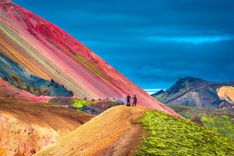13. Hvammsvik Hot Springs
Hvammsvík opened to the public in 2022 and is about a 45-minute drive from Reykjavík. The setup includes eight pools, all at different temperatures, with some as low as 43°F (6°C) and others reaching around 108°F (42°C). Some of them change temperature depending on the tides, since they’re built right where the sea meets geothermal springs.
The pools are spread out across a scenic bay surrounded by mountains. It feels remote, even though it’s not far from the city, so it’s easy to fit in as a quick getaway or as part of a longer trip. Because the pools mix seawater with geothermal water, the mineral content is a bit different from the freshwater ones elsewhere—more like thalassotherapy, if you’ve tried that.
During construction, Viking remains were found on the land, so some areas were preserved as part of Iceland’s archaeological heritage.
How to get to Hvammsvík Hot Springs
Drive north from Reykjavík on Route 1, then take the coastal road toward the bay. It’s about 45 minutes in total, with the last stretch winding past farms and mountain views. Public transit doesn’t go all the way out here, so you’ll need a car or to book a tour.
When to visit Hvammsvík Hot Springs
Weekdays tend to be quieter, especially outside peak hours. During high tide, some of the pools blend into the ocean, which is a nice touch. Winter evenings are great if you’re hoping to catch the northern lights while soaking, and spring brings birds to the surrounding wetlands. The hot springs are open year-round, though hours shift with the seasons.
14. Reykjadalur Steam Valley
Just above Hveragerði, Reykjadalur is a valley filled with geothermal activity, hiking trails, and a hot river you can bathe in. The name means “Steam Valley,” and once you’re up there, it makes sense—the whole place steams. The farther upstream you go, the hotter the water gets, so you’ll want to test a few sections until you find one that feels right.
The trail to the river takes you past bubbling mud, colorful mineral patches, and plenty of steam vents. It’s a popular hike. Boardwalks were added in 2018 to help protect the fragile landscape and make getting in and out of the water easier.
How to get to Reykjadalur Steam Valley
From Reykjavík, drive about 45 minutes east on Route 1 to the town of Hveragerði. There’s a marked parking area at the trailhead just outside town. The hike to the river takes around 60–90 minutes each way and climbs steadily uphill, so decent shoes are a must—especially if it’s been raining (see our Iceland travel health tips for more on that).
When to visit Reykjadalur Steam Valley
Summer and early fall are best for hiking, but winter can be surprisingly beautiful too, with steam rising through the snow. Early mornings or midweek visits are your best bet if you want to avoid crowds. Just keep an eye on the forecast—it can change fast in the highlands.















